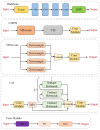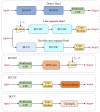A Multi-Task Network Based on Dual-Neck Structure for Autonomous Driving Perception
- PMID: 38475082
- PMCID: PMC10935359
- DOI: 10.3390/s24051547
A Multi-Task Network Based on Dual-Neck Structure for Autonomous Driving Perception
Abstract
A vision-based autonomous driving perception system necessitates the accomplishment of a suite of tasks, including vehicle detection, drivable area segmentation, and lane line segmentation. In light of the limited computational resources available, multi-task learning has emerged as the preeminent methodology for crafting such systems. In this article, we introduce a highly efficient end-to-end multi-task learning model that showcases promising performance on all fronts. Our approach entails the development of a reliable feature extraction network by introducing a feature extraction module called C2SPD. Moreover, to account for the disparities among various tasks, we propose a dual-neck architecture. Finally, we present an optimized design for the decoders of each task. Our model evinces strong performance on the demanding BDD100K dataset, attaining remarkable accuracy (Acc) in vehicle detection and superior precision in drivable area segmentation (mIoU). In addition, this is the first work that can process these three visual perception tasks simultaneously in real time on an embedded device Atlas 200I A2 and maintain excellent accuracy.
Keywords: drivable area segmentation; lane line segmentation; multi-task learning; vehicle detection.
Conflict of interest statement
The authors declare no conflicts of interest.
Figures
Similar articles
-
Multi-Task Environmental Perception Methods for Autonomous Driving.Sensors (Basel). 2024 Aug 28;24(17):5552. doi: 10.3390/s24175552. Sensors (Basel). 2024. PMID: 39275463 Free PMC article.
-
Mobip: a lightweight model for driving perception using MobileNet.Front Neurorobot. 2023 Dec 4;17:1291875. doi: 10.3389/fnbot.2023.1291875. eCollection 2023. Front Neurorobot. 2023. PMID: 38111713 Free PMC article.
-
A Review of Vision-Based Multi-Task Perception Research Methods for Autonomous Vehicles.Sensors (Basel). 2025 Apr 20;25(8):2611. doi: 10.3390/s25082611. Sensors (Basel). 2025. PMID: 40285295 Free PMC article. Review.
-
A panoramic driving perception fusion algorithm based on multi-task learning.PLoS One. 2024 Jun 4;19(6):e0304691. doi: 10.1371/journal.pone.0304691. eCollection 2024. PLoS One. 2024. PMID: 38833435 Free PMC article.
-
Recent Developments on Drivable Area Estimation: A Survey and a Functional Analysis.Sensors (Basel). 2023 Sep 3;23(17):7633. doi: 10.3390/s23177633. Sensors (Basel). 2023. PMID: 37688088 Free PMC article. Review.
References
-
- Redmon J., Farhadi A. Yolov3: An increme-ntal improvement. arXiv. 20181804.02767
-
- Wang C.-Y., Bochkovskiy A., Liao H.-Y.M. Scaled-YOLOv4: Scaling Cross Stage Partial Network; Proceedings of the IEEE International Conference on Computer Vision; Nashville, TN, USA. 20–25 June 2021; pp. 13024–13033.
-
- Jocher G. YOLOv5 Release v6.2. 2022. [(accessed on 25 February 2024)]. Available online: https://github.com/ultralytics/yolov5/releases/tag/v6.2.
-
- Wang C.-Y., Bochkovskiy A., Liao H.-Y.M. Yolov7: Trainable bag-of-freebies sets new state-of-the-art for real-time object detectors. arXiv. 20222207.02696
LinkOut - more resources
Full Text Sources









